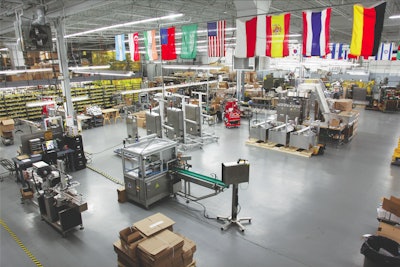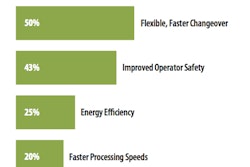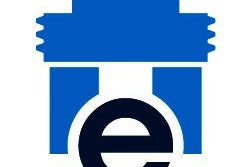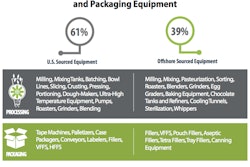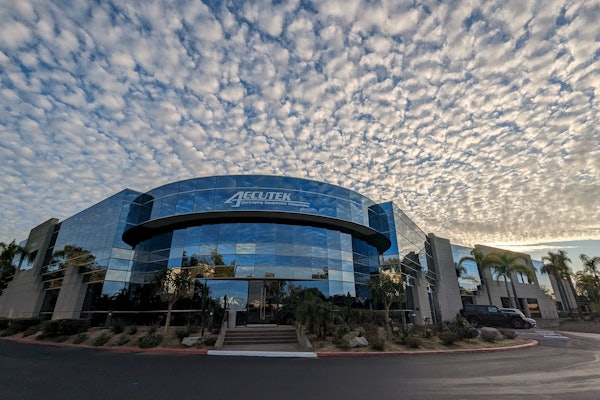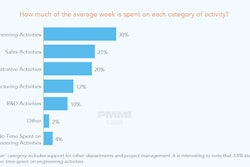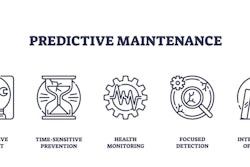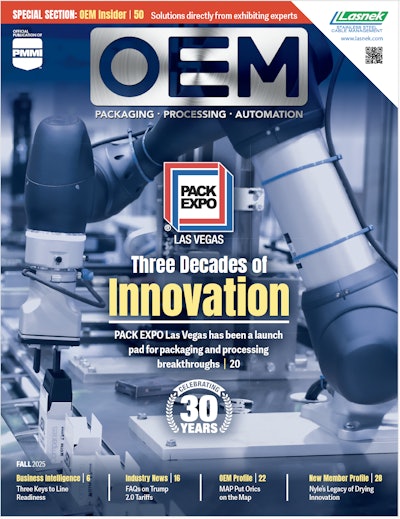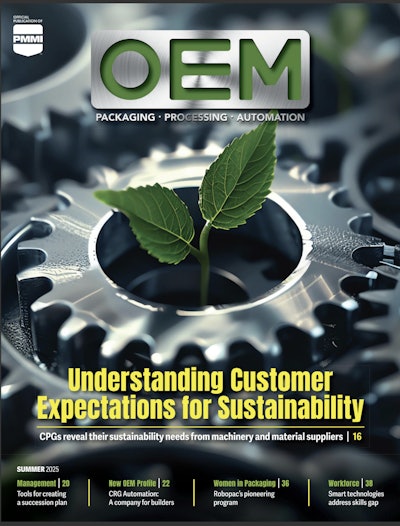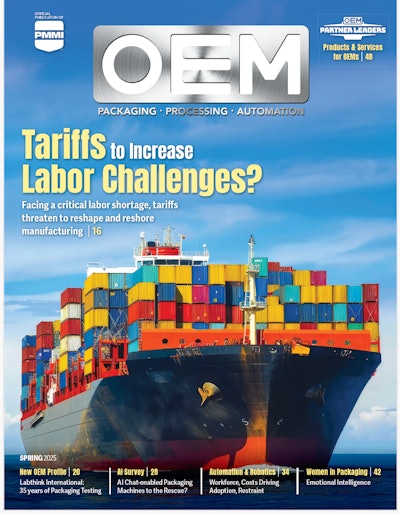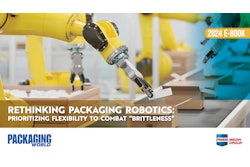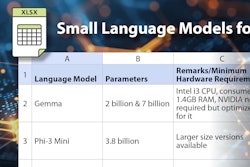Glenn Siegele, president of Omega Design Corp., Exton, Pa., is acutely aware of the pressures a thin workforce puts on manufacturers. When I visited the Exton, Pa. facility to profile the company, his concern was evident in the dull roar of 120 local third-graders getting their first taste of manufacturing during an Omega facility tour. The company is heavily involved with STEM education programs at all levels, from this third graders’ field trip, to internships and partnerships with local trade colleges and manufacturing alliance memberships.
So why the devotion to manufacturing promotion and education? There’s a stat that keeps Siegele up at night. It says that close to 40 percent of the existing manufacturing knowledge base is going to be retiring in the next seven years. This means that 30-plus years of institutional knowledge will soon be drying up. This daunting prospect inspired a dual-pronged approach, first in nurturing talent in the area and making students aware of STEM education, and second in a strong training program once talent is identified.
“There’s a cynical sentiment out there that worries some executives, ‘What if I train them, and they leave?’” Siegele says. “But my worry is, ‘What if we don’t train them, and they stay?’ So if we’re a responsible company with our employment practices and give rewarding opportunities, then hopefully we’ll keep the best and brightest that we’ve educated and trained.”
This attitude permeates the business. Currently, Omega has two employees enrolled in PMMI’s Leadership Development classes, designed to offer 360° of feedback on communication, leadership style, and opportunities for improvement.
While this program comes strongly recommended by graduates and their financiers, it certainly isn’t free. But the company culture steeped in workforce training and development deems such participation to be an investment, not a cost. More specifics on Omega’s commitments are available in the sidebar on page 18, but suffice it to say that distinguishing company characteristics, like cross-functional R&D and ability to anticipate market trends, are strongly underpinned by a commitment to the workforce of today and tomorrow.

Core competencies and recent paradigm shifts
Omega built its reputation on selling discrete components of the packaging line including bottle unscrambling, shrink bundling, and desiccant feeding equipment. However, Siegele considers Omega’s identity, at least in its current iteration, to be both a packaging automation provider and serialization module integrator. Customers, other OEMs, and systems integrators partner with the company to implement serialization solutions throughout their packaging lines. Omega’s proprietary and integrated designs offer unique solutions for individual container identification to support brite stock for private labeling, container serialization for pharma’s track and trace needs, and brand protection, among other initiatives.
“What makes us unique in this area is that we focus on doing the material handling and controls integration, which we believe are our core competencies. Instead of trying to do it all when we know we truly excel in material handling and controls, we partner with best-in-class vision and software companies to deliver the best total solution. So, we occupy a unique space in both semi-automatic and automatic serialization operations,” Siegele says. “The addition of serialization integration to the business was a big shift. We’re leaning on more PMMI partner OEM companies, and sourcing their equipment into Omega’s solutions. Previously with pharma, we would typically sell one line at a time. But serialization opens us up to an increased volume opportunity, which for us, is a positive paradigm shift. We have a much better forecasting capability at these greater volumes, multiple line opportunities and staggered deliveries over a longer time horizon.”
Another sea change has been a strategic change of focus from automatic to semi-automatic case packing machines. Omega understood that customers didn’t want to be pushed into automatic case packing investments and saw a need for high integrity manual and semi-auto end-of-line solutions. This market anticipation is a hallmark of how the company has competed throughout its history, succeeding by identifying a new, emerging opportunity, and generating solutions that are new to the market. For instance, Omega was the first to patent unscrambling machines, and anticipated the need for desiccant feeding in the ‘80s.
“The move into semi-automatic from automatic is another emerging opportunity, where there were holes that needed to be filled. We knew OEMs were making good automatic case packers. But half of the pharma lines out there are manual,” Siegele says. “If you want to serialize that with high integrity, you’re adding tasks for the operator, which will slow him down and hurt OEE. By adding some sort of semi-automation, you can not only get higher levels of integrity, but you can improve OEE.”
Space is also an issue, and full automation takes up a lot of it. Plus, the throughput rates for many specialty and niche drugs, or drugs with diminishing popularity, are often comparatively low. They don’t run at the high volumes and high rates of speed needed to justify the expense and capability of an automatic.

Sales structure
Omega sells through exclusive, independent regional manufacturers’ reps. The business was founded on this type of structure and will remain as such for the foreseeable future.
“Our philosophy has always been that we really don’t try to do, or want to do, direct sales,” says Randy Caspersen, VP, sales and marketing. “Instead of incurring the fixed costs of a company-employed sales force, we strive to have the very best independents out there representing us. A lot of our rep organizations have been with us for more than 20 years, so we’re happy with our existing structure and our existing rep relationships.”
Though they’re not true employees, due to the long relationship they are part of the Omega family. Omega holds what’s equivalent to regional sales meetings by flying reps in, putting them up at hotels, and holding several days of meetings, classroom sessions, machine training, and the usual fun activities.
Tearing down silos
Omega stresses a culture of collaboration. Employees are willing to compromise to keep the focus on what’s best for the company as a whole rather than what’s best for individual departments.
Currently, the shop floor is a mix of cellular manufacturing with point-of-use inventory carts deployed throughout. Each machine’s bare frame is placed in the appropriate cell, at the very spot it will eventually be tested in an FAT. All components are kitted into carts and brought to the frame for assembly. The point-of-use mentality streamlines the system and allows Omega to be smart with parts inventory. The company had used an MRP system, but is currently evaluating more broadly capable ERP systems to control all incoming inventory, among other things.
“We used to have a more traditional progressive build layout, with a mechanical area in the back corner, a separate electrical area, and a storage area, and then we would bring the machines out to a testing area. And it made for a lot of wasted effort. If there wasn’t a space available at one station, we couldn’t build the next machine,” Siegele says. “So now, we bring everything to the appropriate cell—all the tools and all the bolt carts are mobile.”
This segmented layout used to be a matter of necessity, given the broad range of dissimilar machines being built. Siegele likened the product range to an auto manufacturer making cars, minivans, motorcycles, and gravel trucks, and having a deep variability in sizes and speeds within each category.
“We may have had some commonality in casters, but that was about it. So when moving into a more cellular style, we had to balance frequency with continued flexibility. Since our founding, our flexibility and responsiveness during the build phase, and having a strong customer service, have been our hallmarks. Still, we really are a configure-to-order, not a pure build-to-order. Even though there’s a little bit of custom on everything, we saw that we could benefit by moving to a less segregated manufacturing environment,” he says.
As an immediate outgrowth of the new cellular and point-of-use layout, Omega is now better able to cross-train employees. There’s a lot more cross-pollination of ideas and capabilities these days, in what used to be a very “silo’d” format. Gone are the days of the bander guys being relegated to “bander-land,” and the unscrambler guys to their own patch, rarely to meet.
“We do have subject matter experts in different product lines, but most guys can work on any machine. We have a production lead, we have assemblers, or production tech one, two, and three, and production lead one, two, and three, but they aren’t designated for one machine. And they’re not paired up as dedicated teams, so at one time, a production lead might be working with two different production techs. It’s fluid, based upon demand and the machine coming up next,” he says. “And that gives us a lot more flexibility than we had when we were all working in our respective departments.”

This cross-capability seeps into R&D. There is no dedicated R&D department at Omega. Instead, the company leverages its cross-trained employees to follow cross-functional new product development. These are sometimes called “tiger teams” in high tech parlance, and harness expertise from service, sales, engineering, and especially, production.
“Of course, if it’s a product that has a specific kind of technology, we’ll select some specific people. But that said, you could make a mistake if you bring the same people to the same meeting every time,” Siegele says. “Innovation comes from all levels of the company.”
Picking the right parts for GDT
One recent evolution at Omega has been in the humble, but critical arena of machine frames. Welded frames for rotary pocket (RP) unscramblers hadn’t changed much since the mid-1980s for the company. But newer servo-controlled unscramblers (SRPs) rely on some precise relationships between different pieces of framing stock. Given the number of weldments, precision shimming, and careful sizing, these weldments took hours of craftsmanship that wasn’t very repeatable.
A long-standing, but infrequently applied technology—Geometric Dimension and Tolerancing (GD&T)—changed this approach. GD&T is a tolerancing language for mechanical designers that has been around for decades but is not in widespread use due to people’s misconception that it always makes a part more costly to manufacture. While that is true at times, if applied correctly it only makes those parts more costly that need to have that level of precision, and absent that precision the designer puts the entire assembly or machine’s purpose at risk.
The result? The joints and stock relationships just fell together without having to slot or tinker. The solution used precision machined holes and dowel pins instead of potentially sloppy bolts to precisely hold those relationships.
Now just three parts—the mounting plate, the upright, and the top plate—are controlling the relationship between the top of the chute, to the bottom of the chute, to the pickoff. And now, the machine exhibits better pickoff, rates, and speed. It also goes together more quickly; nobody’s spending hours fussing with it. This gives Omega a quicker build, shorter lead time, lower-cost, and better quality.
“It’s a matter of applying GD&T to the right stuff, but not everything. Because if you over-tolerance the wrong stuff, you could be paying a lot of money for parts that don’t require that precision,” Siegele says. “Not all our vendors understand GD&T, but the few that do are more sophisticated, and in the end the parts themselves might be more costly to purchase. The payback is in the time saved in the shop to assemble a machine, the very performance of which relies on the precise part-to-part relationships that GD&T provides, and so eliminates hours, even days, of fussing and tweaking. Still, you want to be judicious in your tolerancing for better economic value on the parts that need it.”
Growing the machine shop (and the talent within)
Omega has machine shops both in-house and off-site to help with flexibility and keep up with parts and component demand. The combination of internal/external fabrication and machining helps with capacity planning; with capital equipment sales being so spotty and lumpy, it’s hard to have a dedicated machine shop producing all components. But still, it’s good to have the capability to do emergency parts or minor modifications in-house, especially with the local suppliers often being small and with limited capacity and capability.
Omega’s machine shops represent yet another arena that leverages local schools to strive for strong training and workforce development. Siegele leans heavily on the nearby Manufacturing Alliance of Chester and Delaware Counties (MACDC) and associated community college programs to share the burden of workforce development. Joshua Jones, an Omega machinist, currently is a CNC student at a nearby community college who takes advantage of this relationship.
“Because we’re a member of MACDC, we get discounted tuition rates. The school was generous enough to donate those discounted rates to members of the alliance,” Siegele says. “So, Joshua is going on his own time, we pay whatever fees there are, and now we’re going to be adding another machine tool to expand the machine shop with him helping to man the expansion. We are looking to keep expanding the machine shop, and we’re growing the workforce to staff it from within.”
What’s next
Omega aims to grow into new regional markets in coming years. It already is in 45 countries, but so far, that’s largely a result of being pulled there by large global pharma accounts that it already has.
“It’s not like we haven’t been global but it’s been difficult to find good sales channels in some regions. It would be good if we could take another look at that. Some areas that we used to be in quite strongly have changed due to the economics of the region, Venezuela and Mexico for instance,” Caspersen says.
Also, to a certain extent, Omega hasn’t more actively sought more international business because it has been doing so well in the U.S. Between 70 and 80 percent of sales are domestic.
“But I’d like to have an export business that’s more purpose driven, rather than happenstance,” Siegele says. “This certainly means we have to develop some more service capabilities in other countries. Foreign companies want to have local service just like domestic companies do. So we are having some discussions with companies, other OEMs, and PMMI about how we can do that.”
Siegele is also keeping a close eye on how medicine is being delivered. Case in point: the traditional solid, oral dose medication vehicle might be economical and convenient, but it’s likely not the best way to deliver medicine to a patient.

“There will be changes in pharmaceuticals coming, and we need to be ready,” he says. “One of the big shifts in that industry is that we’re moving away from big, blockbuster drugs running at 360/minute—fast for pharma. Companies are breaking up the drug formulation where a single formulation would be recommended for, say, all men over 40. Drugs are becoming more targeted, more tailored to smaller demographics of people. “
As such, Siegele anticipates a reduction in one-size-fits-all drugs, and smaller batches of even more SKUs. Different package regulations in different countries will further splinter the number and format of drug packaging, which has implications for pharma process and packaging machinery alike. But this shift isn’t sneaking up on Siegele. One of Omega’s defining characteristics is its ability to forecast, react to, and capitalize on these types of trends. But perhaps more importantly, the company is taking proactive steps to be sure it has an engaged, well-trained workforce ready to tackle head on the next big pharmaceutical packaging machinery trend.
